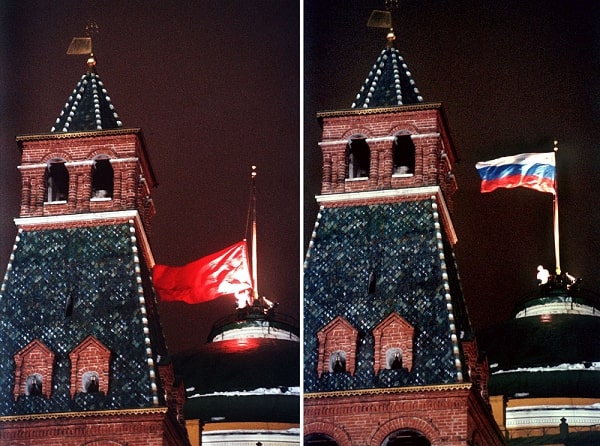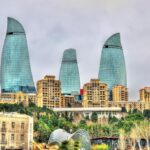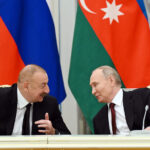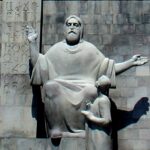GKChP (August Coup)
Boris Yeltsin’s election as President and the new future alliance of the Union republics worried the powers that be. KGB chief Kryuchkov asked Gorbachev to declare a state of emergency in the USSR. A group was forming against the USSR government and the RSFSR, consisting of Defense Minister Dmitry Yazov, Interior Minister Boris Pugo, Prime Minister Valentin Pavlov, Vice President Gennady Yanayev, and Oleg Baklanov, a member of the USSR Defense Council. On July 21, 1991, Gorbachev, Boris Yeltsin, and Nursultan Nazarbayev met to agree on the transformation of the USSR government and the replacement of Pavlov, Yazov, Kryuchkov, and Pugo with more liberal figures. Since the KGB had wiretapped the venue and listened in to the conversation, the transcript was sent to Kryuchkov.
On August 4, 1991, Gorbachev and his family went on vacation to their spring residence in Crimea. Gorbachev was to return to Moscow on August 20 when the new union treaty was to be signed. On August 17, Yanayev, Yazov, Pavlov, Kryuchkov, and Pugo met in the KGB building to discuss the new union treaty. They agreed that the treaty would destroy the Soviet Union and that a military coup was necessary to prevent it. (Yanayev, 2009:99). On August 18, Oleg Baklanov, Valery Boldin, Oleg Shenin, and USSR Deputy Defense Minister Valentin Varennikov left for Crimea to meet with Gorbachev. The KGB cut off all of Gorbachev’s communications with the outside world. It was virtually a house arrest. The visitors, Baklanov, Boldin, Shenin and Varennikov, demanded that Gorbachev either declare a state of emergency or hand over all authority to Vice President Gennady Yanayev to maintain order in the country.
According to Gorbachev, he rejected all their demands. According to Varennikov, however, Gorbachev said, “Do what you want.”
After Baklanov, Boldin, Shenin and Varennikov returned from Crimea, a meeting was held in the Kremlin. Gennady Yanayev, Valentin Pavlov and Oleg Baklanov signed a statement declaring martial law in the USSR and establishing the State Committee on the State of Emergency (GKChP). After that, Yanayev signed a decree stating that Gorbachev could not fulfill his duties “due to the state of his health” and all his authority passed to the Vice President. The GKChP declaration was announced to the public on August 19 at 07:00. All television, radio and newspapers affiliated with the RSFSR were reportedly cut off the air. Although the conspirators planned to arrest Yeltsin, who was on his way to Kazakhstan, when he returned to the country, they were unable to do so. Yeltsin appeared in front of the building of the Supreme Soviet of the RSFSR, declared the military coup unconstitutional and called on the people to take to the streets.
After Yeltsin’s appeal, thousands of Russians of different ideologies began to gather in front of the White House (the building of the Supreme Soviet of the RSFSR). The vast majority of them were members of the Democratic Russia movement. Even anarchists took to the streets to support Yeltsin. The coup attempt was aimed at taking over and dissolving the Supreme Soviet of the RSFSR, and arresting all deputies in the event of resistance. The Taman tank division was prepared for this purpose. However, although thousands of people gathered in front of the White House, no attempt of a tank attack was made. On the third day of the confrontation, part of the army sided with Yeltsin. Nevertheless, the army was waiting for the order to attack the building. Defense Minister Yazov did not agree to the bloodshed, and the military coup ended in a failure. Thus, power was now completely in the hands of the President of the RSFSR Yeltsin. After this incident, the GKChP, the CPSU, the KGB of the USSR, and other government agencies of the USSR were dissolved. (Sakwa, 1999:472).
Belovezh Accords and the fall of the USSR
After the attempted military coup in August, the Union republics began to adopt declarations of independence one by one. However, these documents were meaningless if the center did not recognize them. The Union of Sovereign Republics was still on the agenda. On September 5, 1991, the 5th Congress of People’s Deputies of the USSR adopted the law “On State authorities of the Soviet Union during transitional period.” Thus, a transition period was announced for the formation of a new system of state relations, the drafting and signing of the treaty on establishing the Commonwealth of Independent States. After this, the Congress of People’s Deputies was dissolved at Gorbachev’s suggestion.
On September 6, the USSR State Council accepted the withdrawal of the three Baltic republics (Latvia, Lithuania and Estonia) from the USSR and recognized their independence. On November 14, 1991, the leaders of seven of 12 Union republics (Russia, Belarus, Kazakhstan, Kyrgyzstan, Tajikistan, Turkmenistan, Uzbekistan) and Soviet President Mikhail Gorbachev announced their intention to sign an agreement on the establishment of the Union of Sovereign Republics. Ukraine and Azerbaijan were to join them. However, after the August coup attempt, Boris Yeltsin was skeptical of the Union of Sovereign Republics and was not going to allow it to happen. Ukraine’s independence was declared in a referendum on December 1. Boris Yeltsin immediately recognized Ukraine’s independence and said that he intended to sign a bilateral agreement with it. (Pikhoya, 1998:621).
In a meeting with Gorbachev on December 5, Yeltsin said that the Union of Sovereign Republics would be meaningless without Ukraine. Yeltsin later told US President George W. Bush that only two of the seven republics were Slavic and the rest were Muslim, so it was impossible to reach an agreement. In order for Yeltsin to finally end the USSR, the President of Belarus, Shushkevich, decided to sign an agreement with the President of Ukraine, Kravchuk, and began the talks. Unbeknownst to Gorbachev, the presidents of the three republics met in Belovezhskaya Pushcha National Park. According to Stanislav Shushkevich, Kazakh President Nursultan Nazarbayev was to attend the meeting as well. Instead of Belovezhskaya Pushcha, however, Nazarbayev went to Moscow. Nazarbayev would later say this about the Belovezh meeting: “I would never have signed such an agreement.”
Thus, on December 8, Shushkevich, Kravchuk and Yeltsin signed an agreement on the dissolution of the USSR and the establishment of the Commonwealth of Independent States in its place. The irony of the agreement was that the first person Yeltsin called after the signing was the US President. (Gorbachev did not know about it yet). A day after the signing of the agreement, Gorbachev declared that each Union republic had the right to secede from the union, but that the fate of a multinational state could not be decided by the will of the leaders of three republics.
It was still possible to save the USSR. On December 11, the Committee of Constitutional Supervision said that “USSR could only be dissolved in an appropriate constitutional procedure.” Besides, although the Belovezh Accords were signed, the document had to be ratified by the parliaments of all three countries. On December 12, 188 out of 201 deputies in the Supreme Soviet of the RSFSR voted in favor of the agreement, with 6 votes against and 7 abstentions. Those who voted against the dissolution of the USSR were the centrist faction of which Sergei Baburin was a member. (Pikhoya, 1998:623). With the exception of two deputies, all ex-communists supported the collapse of the USSR. In the Supreme Soviet of Ukraine, only one person (Albert Korneyev) voted against the agreement. The only person in the Supreme Soviet of Belarus to oppose the agreement was the country’s now incumbent President Alexander Lukashenko.

After the parliaments of 3 states ratified the establishment of the CIS, 8 other states remained. At the conference in Almaty on December 21, Moldova, Azerbaijan, Armenia, Kazakhstan, Uzbekistan, Kyrgyzstan, Tajikistan and Turkmenistan signed the protocol supporting the dissolution of the USSR and the establishment of the CIS. (Shumilov, 2008:547). On December 25 at 7 p.m., Mikhail Gorbachev went on television to announce his resignation as President of the USSR. On December 26, the Soviet of Republics, the upper chamber of the USSR Supreme Soviet, convened in the Kremlin for the last time. At this meeting, the deputies from the five Asian republics remaining in the Union to the end signed the “Declaration on the dissolution of the Soviet Union as a state and subject of international law.”
The dissolution of the USSR was now official.
Conclusion (Causes of the collapse of the USSR)
Before analyzing the most important factors in the collapse of the Soviet Union, we have to understand how the country was governed. Russia had been a semi-feudal country in Tsarist times, with capitalist economic relations only in major cities. The Marxist theory could not be applied in this type of state. In Tsarist Russia, this required both a bourgeois democratic revolution and industrialization.
Although the leader of the Russian Marxists, Lenin, agreed with the first statement, he did not accept the second. According to Lenin, the revolutionary party could seize power and begin industrialization, and a transition period was not required for that. The Bolsheviks came to power on October 25, 1917. They won the civil war, which lasted about four years. Lenin believed that with the establishment of the USSR, the revolution would triumph in Europe. However, the revolutions that took place in Europe in 1918-1920 did not bear fruit. The state had to choose a new goal. This goal was called a “strategic retreat from socialism” to state capitalism, the New Economic Policy (NEP).
After Lenin’s death, Stalin seized power. Stalin believed that under the slogan of “socialism in one country” put forth by Bukharin, socialism could fight capitalism economically. The mainstays of this fight were collectivization and industrialization. In the 1936 Constitution, Stalin declared the establishment of socialism in the Soviet Union. The next goal was communism. In his speech in 1952, Stalin said that he expected the country to reach the peak of its transition to communism in 1970.
Under Malenkov and Khrushchev, who came to power after Stalin, the forecasts regarding the establishment of communism became more pessimistic. According to Nikita Khrushchev, communism was to be established in 1980. Khrushchev was also completely opposed to Marx, saying that the institution of state would not die in communism.
Under Brezhnev, who came to power after Khrushchev, the ideal of communism was pushed into the background and replaced with the slogan of “developed socialism.” Andropov and Chernenko were in power for too short a period to be able to make significant changes to the Soviet system. Mikhail Gorbachev, who came to power in 1985, inherited three main problems that had formed within the government since 1930:
- Economic problem
- Military and resource problem
- Ideological problem
1. In 1914, Russia had the eighth most developed industry in the world. The industrialization that took place under Stalin was a great success. One of the main reasons for this was Russia’s abundance of natural resources. The USSR did not import anything except rubber. During this period, the USSR was to a great extent isolated from the world economy. Stalin remained committed to the Marxist industrialization model, the main goal of which was the development of industry spread evenly throughout the country. Large industrial cities were built in isolated areas. Convicts and later German prisoners of war began to be used in the building of these cities.
The Soviet economy grew significantly under Stalin, second only to the United States in terms of GDP. However, with Khrushchev coming to power, the growth rate achieved in the 1950s gradually declined. If national income grew 7.2% in 1966-1970, it fell to 5.1% in 1971-1975, 3.8% in 1976-1980, and down to 3.1% in 1981-1985. (Sakwa, 1999:413).
In the 1960s, the Soviet Union entered the world market as a major oil exporter, and in the 1970s as a natural gas exporter. As a result of the Arab-Israeli War, which began in October 1973, and the subsequent oil embargo proclaimed by the Arab states, oil prices quadrupled. Using the rising oil revenues, the weakened Soviet economy was able to meet the needs of its enormous military-industrial complex. Agriculture, on the other hand, was in decline. During Khrushchev’s rule, the USSR began importing grain, a policy that continued under Brezhnev. (Interestingly, the USSR was able to carry out industrialization thanks to the revenues from grain exports).
Food imports were now needed to prevent food shortages and social instability. Oil was used to fulfill the agricultural plan. Chair of the USSR Council of Ministers Alexei Kosygin called the Minister of Oil and Gas Industry and said, “Things are bad with bread. Give me three million tons [of oil] over the plan.” (Yergin, 2016:29). Rising oil prices allowed the Soviet Union to go on without reforming its economy or altering its foreign policy. The Soviet leadership did not take the possibility of oil prices falling someday seriously and was not prepared for such an eventuality. Thus, Gorbachev, who came to power in 1985, faced serious problems. In 1986, oversupply and declining global demand triggered a collapse in the oil price. The country lost a significant part of its hard currency earnings. Although the Soviet oil industry continued to push up output, this was not enough to save the sinking economy.
Another major problem was the shortage of some types of clothing and commodities. In Gorbachev’s early days in power, he even set up a commission to solve the problem of women’s pantyhose. Gorbachev lamented: “Imagine a country that flies into space, launches Sputniks, creates such a defense system, and it can’t resolve the problem of women’s pantyhose.” (Yergin, 2016:30). There was also a shortage of toothpaste and laundry detergent. The country had an official, planned economy and a shadow economy, the latter growing faster than the former. Gorbachev did not understand how the Soviet economy worked. Therefore, instead of remedying the situation, he introduced many economic reforms that made it worse.
2. The Soviet Union had to be protected in order to build communism all over the world and to defend itself. The Soviet military-industrial complex accounted for at least 40% of national income. No one knew the exact figure, not even the leader. (McCauley, 2007:442). It was only during Gorbachev’s rule that defense spending was reduced. Arms expenditure was crippling the Soviet Union. The arms race was one of the many reasons behind the country’s demise.

On the other hand, the USSR spent a lot of its resources on revolutionary movements in other republics and on other socialist states. One of the countries most subsidized by the USSR was the German Democratic Republic. GDR was resource poor, so it received constant support from the USSR. During the perestroika, Hans Modrov, the GDR Prime Minister, wrote to Gorbachev in response to the reduction of Soviet aid: “The German Democratic Republic is the Soviet Union’s child. Please care for us.” Strange as it may seem, the Warsaw Pact states aimed to run a trade deficit with the Soviet Union because that meant that they were getting credit from Moscow. It was rational economic behavior from their point of view. The Soviet Union’s influence in the Third World was also strong. Countries such as Ethiopia, Angola, Mali, the Democratic Republic of the Congo, and Mozambique fought against Western imperialism. As an international state, the USSR had to help these crusaders. Other communist states, such as Laos and Vietnam, also expected Soviet largesse. Among the countries supported by the Soviet Union, Cuba was most favored. The Soviet Union paid well over the world market price for Cuban sugar cane and gave it everything almost for free.
Assistance was also provided to communist circles and parties in European countries and the United States. The USSR had very good relations with the Western Communist Parties, especially the Italian Communist Party. The US Communist Party was also funded directly from Moscow. The most damaging to the Soviet Union was the Afghan campaign. In this war, which lasted for 10 years, the USSR suffered great material and human losses. To quote Gorbachev, Afghanistan was an “open wound.” This disastrous adventure ended in February 1989. In order to get rid of financial burden, the USSR withdrew its army first from Afghanistan and then from Eastern Europe. Although Gorbachev was an ally of Iraq, he did not support Saddam Hussein during the latter’s invasion of Kuwait on August 1, 1990. The USSR was living its last days. The state needed Western credits to survive.
The Americans offered Gorbachev $1.5 billion to buy grain. In London, in July, he asked for a lot of money again, reminding President Bush that the West had found $100 billion to fight the Iraq war. Bush refused. (McCauley, 2007: 434).
The USSR was hanging by a thread.
3. The ideological degradation was arguably the most important factor in the fall of the Soviet Union. The main culprit of the ideological degradation was Stalin. It was during Stalin’s rule that the system of democratic choice, freedom of expression and collective governance in the Politburo was disrupted. The vast majority of the founding members of the state (Lenin’s old guard) were killed in the repressions of the 1930s. The Politburo had already become a reluctant group of people who accepted Stalin’s every word and applauded his every idea. It was the lack of free thought and pluralism that resulted in ladder climbers coming to power in the state apparatus, instead of real communists.
The real consequences of this can be seen in Khrushchev’s and Brezhnev’s governance. Under Brezhnev, the state apparatus became completely corrupt, and embezzlement of socialist state property was commonplace. Every worker was stealing something from the enterprise where they worked, every peasant was stealing from their collective farm. Workers became increasingly disassociated from their work, no longer seeing the socialist state property as their own. Socialist competition could not replace market institutions. An engineer was paid less than a worker, and a foreman received the same amount as his subordinates. There was no incentive to work. Honest people could not be represented in office because bureaucrats were corrupt.
All these factors manifested themselves more explicitly during the perestroika. In 1990, Russia’s finance minister declared that only 20% of the Party members were Marxists. Another analyst said that one-third of the Party members were committed to Marxism and three-quarters were in the Party only to advance in their careers. The ideological degradation was especially apparent in the decay of the Komsomol. The Komsomol raised smart capitalists instead of honest communists. Some oligarchs, such as Mikhail Khodorkovsky, began making money when they were in the Komsomol. Many Russian oligarchs were already dollar millionaires under Gorbachev. For example, Mikhail Fridman became rich by selling theater tickets on the black market. Fridman, currently one of Russia’s richest men, is now head of Alfa Bank.
The death of ideology is also evident in the vote in the Supreme Soviet of the RSFSR on the dissolution of the USSR. In the 86% communist parliament, only seven people voted against the dissolution of the USSR. Every politician formed parties with different ideologies a year later, and completely different views on life and socio-economic relations emerged. As they say, rats are the first to abandon the sinking ship.
References
Sakwa, Richard (1999) The Rise and Fall of the Soviet Union, 1917-1991
McCauley, Martin (2007) The Rise and Fall of the Soviet Union
Yanayev, Gennadiy (2010) GKCHP protiv Gorbacheva: posledniy boy za SSSR [Yanayev, Gennady, GKChP Against Gorbachev: The Last Battle for the USSR]
Shumilov, Mikhail (2008) Istoriya Rossii: konets XIX-nachalo XXI vekov [Shumilov, Mikhail, History of Russia: Late 19th–Early 21st Centuries]
Pikhoya, Rudolf (1998) Sovetskiy Soyuz: Istoriya Vlasti 1945–1991 [Pihoya, Rudolf, Soviet Union: A History of Power 1945–1991]
Yergin, Daniel (2012) The Quest: Energy, Security, and the Remaking of the Modern World










